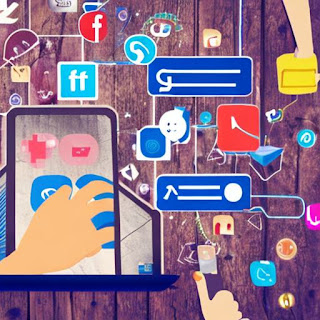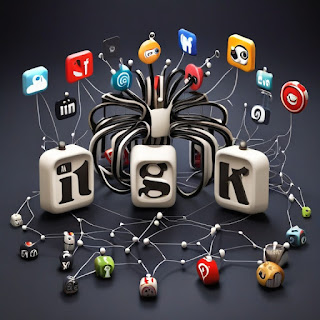In the ever-evolving world of social media, the concept of
influencers has become a dominant force. These individuals, with their large
followings and persuasive abilities, have the power to shape trends, influence
consumer behaviour, and drive brand partnerships. However, a new trend is
emerging within the realm of social media influence - the rise of AI-powered
virtual influencers. These computer-generated avatars are rapidly gaining
popularity and raising important questions about the future of social media and
the influence of technology.
Social media has become an integral part of our lives, with
platforms like Instagram, YouTube, and TikTok dominating the digital landscape.
Among the key players on these platforms are influencers, individuals who have
amassed a significant following and wield considerable influence over their
audiences. But now, a new is emerging within the world of social
media influence: the rise of AI-powered virtual influencers. These
computer-generated avatars are gaining traction and sparking conversations
about the future of social media and the impact of technology.
So, what exactly are virtual influencers? They are digital
characters created by artificial intelligence (AI) algorithms that mimic human
appearance, behavior, and personality. These virtual beings exist solely in the
digital realm, and yet they interact with followers, post content, and even
collaborate with brands, blurring the line between reality and fantasy. They
are designed to mimic human behavior, appearance, and personality, creating a
seemingly authentic online presence.
The rise of virtual influencers can be attributed to several
factors. One key advantage they offer is complete control. Unlike human
influencers who are bound by physical limitations, virtual influencers can be
online 24/7, creating content without fatigue or downtime. They can also
maintain a consistent aesthetic and personality, eliminating the risk of human
error or controversial behavior that might harm a brand's reputation.
Additionally, virtual influencers provide a level of creative freedom that may
not be possible with human influencers, as they can effortlessly change their
appearance, style, and settings.
Moreover, virtual influencers offer a certain novelty factor
that captivates audiences. Their uncanny appearances and ability to blur the
line between reality and fantasy create intrigue and curiosity among followers.
In a world saturated with real-life influencers, virtual influencers offer a
unique and alternative form of content that can attract and retain attention.
Brands and marketers have also recognized the potential of
virtual influencers as a marketing tool. These AI-powered characters provide a
controlled environment for brand collaborations, as their actions and messages
can be precisely tailored to align with a company's values and marketing
objectives. Virtual influencers are seen as a way to deliver targeted messages
to specific demographics, leveraging AI algorithms to analyze and understand
audience preferences and behaviors.
Will AI-powered virtual influencers replace real-life influencers altogether? While virtual influencers offer certain advantages, human influencers bring an element of authenticity, relatability, and emotional connection that virtual beings cannot replicate. Human influencers have lived experiences, emotions, and stories that resonate with their followers on a personal level. It is this aspect of the human experience that keeps influencer marketing relevant and impactful.
However, the rise of AI-powered virtual influencers also
raises ethical concerns and challenges. The very essence of influencer
marketing lies in the personal connection and authenticity between the
influencer and their followers. Virtual influencers, being computer-generated
entities, lack the genuine human experiences that often resonate with
audiences. This begs the question: Can virtual influencers truly foster genuine
relationships and trust with their followers?
Additionally, virtual influencers blur the line between
reality and fiction, which may lead to potential issues of transparency and
disclosure. Disclosure requirements for sponsored content and brand
partnerships are well-established for human influencers, but when it comes to
virtual influencers, it becomes more challenging to determine if their content
is sponsored or generated autonomously. This lack of transparency can erode
trust and lead to ethical dilemmas for both brands and followers.
Furthermore, the rise of virtual influencers raises concerns
about the future of human influencers. Will AI-powered virtual influencers
replace real-life influencers altogether? While virtual influencers offer
certain advantages, human influencers bring an element of authenticity,
relatability, and emotional connection that virtual beings cannot replicate.
Human influencers have lived experiences, emotions, and stories that resonate
with their followers on a personal level. It is this aspect of the human
experience that keeps influencer marketing relevant and impactful.
In conclusion, the rise of AI-powered virtual influencers
marks an intriguing development in the world of social media. These
computer-generated avatars provide unique opportunities for brands and
marketers to reach audiences in a controlled and tailored manner. However, the
ethical implications, challenges of transparency, and the irreplaceable value
of human influencers should not be overlooked. The future of social media
influence will likely be a blend of real-life and virtual influencers, where
both can coexist and bring their unique strengths to the table. Ultimately, it
is the audience that will decide the fate of AI-powered virtual influencers and
their role in shaping the social media landscape.




Comments
Post a Comment